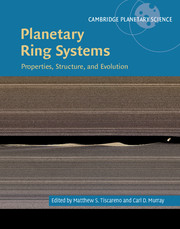Book contents
- Frontmatter
- Contents
- List of Contributors
- Acknowledgements
- I Introductory Material
- II Ring Systems by Location
- III Ring Systems by Type and Topic
- 8 Moonlets in Dense Planetary Rings
- 9 Meteoroid Bombardment and Ballistic Transport in Planetary Rings
- 10 Theory of Narrow Rings and Sharp Edges
- 11 Narrow Rings, Gaps, and Sharp Edges
- 12 Dusty Rings
- 13 The F Ring of Saturn
- 14 Plasma, Neutral Atmosphere, and Energetic Radiation Environments of Planetary Rings
- 15 Thermal Properties of Rings and Ring Particles
- 16 Computer Simulations of Planetary Rings
- 17 Laboratory Studies of Planetary Ring Systems
- 18 The Origin of Planetary Ring Systems
- IV Concluding Material
- Index
- Plate section
- References
14 - Plasma, Neutral Atmosphere, and Energetic Radiation Environments of Planetary Rings
from III - Ring Systems by Type and Topic
Published online by Cambridge University Press: 26 February 2018
- Frontmatter
- Contents
- List of Contributors
- Acknowledgements
- I Introductory Material
- II Ring Systems by Location
- III Ring Systems by Type and Topic
- 8 Moonlets in Dense Planetary Rings
- 9 Meteoroid Bombardment and Ballistic Transport in Planetary Rings
- 10 Theory of Narrow Rings and Sharp Edges
- 11 Narrow Rings, Gaps, and Sharp Edges
- 12 Dusty Rings
- 13 The F Ring of Saturn
- 14 Plasma, Neutral Atmosphere, and Energetic Radiation Environments of Planetary Rings
- 15 Thermal Properties of Rings and Ring Particles
- 16 Computer Simulations of Planetary Rings
- 17 Laboratory Studies of Planetary Ring Systems
- 18 The Origin of Planetary Ring Systems
- IV Concluding Material
- Index
- Plate section
- References
Summary
INTRODUCTION
Ring systems around magnetized planets are expected to have varied interactions with the magnetic fields, hot plasma, and energetic particles of the associated magnetospheres. In our solar system all the giant planets, Jupiter to Neptune, have magnetospheres with embedded rings. Each ring system and its associated moons have strong interactions with their radiation environments (the most intense of which is at Jupiter). Such interactions both erode diffuse rings (such as the E ring of Saturn) and supply plasma and energetic particles to the magnetosphere and its radiation belts. Compositional and structural measurements of rings are enabled by these interactions, such as the information obtained by detection of the secondary neutron and gamma-ray emissions produced by galactic cosmic ray (GCR) interactions with the rings. It is also notable that Earth has both a magnetosphere with radiation belts, and an artificial ring system of satellites and debris, that continuously interact. Konradi (1988) even projected that the high energy trapped protons of the inner Van Allen Belt should now be experiencing significant depletion by this interaction, and we will later discuss the possible evidence for this. Magnetized exoplanets with rings would have similar interactions.
The ring systems of Jupiter and Saturn have been explored by multiple spacecraft. The Jovian ring environment was first explored in situ in 1974 by Pioneer 11, which subsequently flew under Saturn's main rings in 1979. After passing through the Saturn ring plane near the G ring in 1981, Voyager 2 encountered Uranus in 1986 and then Neptune in 1989, but in neither case were the rings and arcs of these two ice giant planets traversed. The Galileo Probe passed across the Jovian ring in December 1995 en route to the first direct penetration into Jupiter's atmosphere. The Cassini Orbiter crossed over the Saturn A and B rings in mid-2004 (Figure 14.1) as part of the Saturn Orbital Insertion (SOI). Cassini will again traverse the main rings during its Grand Finale orbit phase many times, crossing the ring plane just inwards of the D ring, prior to final atmospheric entry in 2017. With the exception of the Cassini Plasma Spectrometer (CAPS) instrument, turned off in 2012 due to electrical problems, Cassini will continue to operate through the final observations.
- Type
- Chapter
- Information
- Planetary Ring SystemsProperties, Structure, and Evolution, pp. 363 - 398Publisher: Cambridge University PressPrint publication year: 2018
References
- 3
- Cited by

